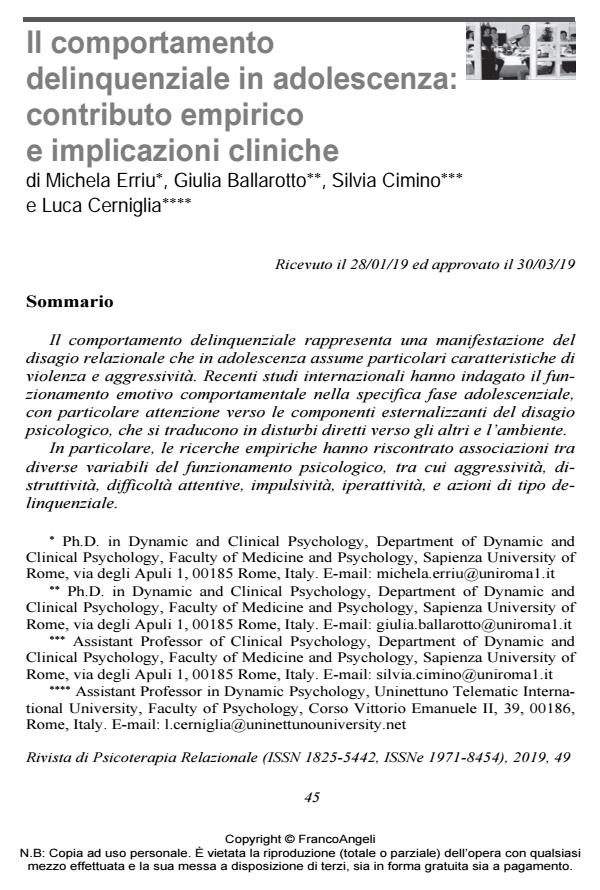Delinquent behavior in adolescence: empirical contribution and clinical implications
Journal title RIVISTA DI PSICOTERAPIA RELAZIONALE
Author/s Michela Erriu, Giulia Ballarotto, Silvia Cimino, Luca Cerniglia
Publishing Year 2019 Issue 2019/49
Language Italian Pages 27 P. 45-71 File size 259 KB
DOI 10.3280/PR2019-049003
DOI is like a bar code for intellectual property: to have more infomation
click here
Below, you can see the article first page
If you want to buy this article in PDF format, you can do it, following the instructions to buy download credits

FrancoAngeli is member of Publishers International Linking Association, Inc (PILA), a not-for-profit association which run the CrossRef service enabling links to and from online scholarly content.
Delinquent behavior represents an element of the individual suffer-ence that during adolescence can revest particular characteristics, such as violence and aggressiveness. Recent international studies have investigated the emotional and behavioral functioning during the specific adolescent phase, with par-ticular attention to the external components of psychological distress, which can in turn lead to direct disorders towards others and the envi-ronmental context. In particular, empirical research has found associations between different variables of psychological functioning, including aggression, destructiveness, difficulty, attention, impulsiveness, hyperactivity, and delinquent actions. Based on recent contributions from the scientific literature on the adolescents’ dysfunctional behavior, this study aims to empirically investigate the emotional-behavioural functioning in a sample of adolescents, with specific attention to delinquent behaviour. In particular, thanks to the collaboration of schools in Central-Northern Italy, a sample of N=346 adolescents (173 males and 173 females) was evaluated through the administration of the self-report questionnaire Youth Self-Report 11/18. The results of the research do not show gender differences with re-gard to the average scores in the scale Delinquent behaviour, whose scores seem to increase with the age of adolescents. Interesting asso-ciations between delinquent behaviour and other aspects of emotional-behavioural functioning have also been found, which seem to vary ac-cording to the age of the adolescents. The results show the relevance of specifically evaluate the development phase in which adolescent be-haviour occurs, in order to be able to manage prevention and/or treatment interventions adapted to specific needs.
Keywords: Adolescence, delinquent behaviour, relationships.
- Dipendenza da Internet e sensation seeking negli adolescenti: uno studio descrittivo Andrea Costa, Alberto Rebaicini, in PSICOLOGIA DELLA SALUTE 2/2021 pp.54
DOI: 10.3280/PDS2021-002005
Michela Erriu, Giulia Ballarotto, Silvia Cimino, Luca Cerniglia, Il comportamento delinquenziale in adolescenza: contributo empirico e implicazioni cliniche in "RIVISTA DI PSICOTERAPIA RELAZIONALE " 49/2019, pp 45-71, DOI: 10.3280/PR2019-049003